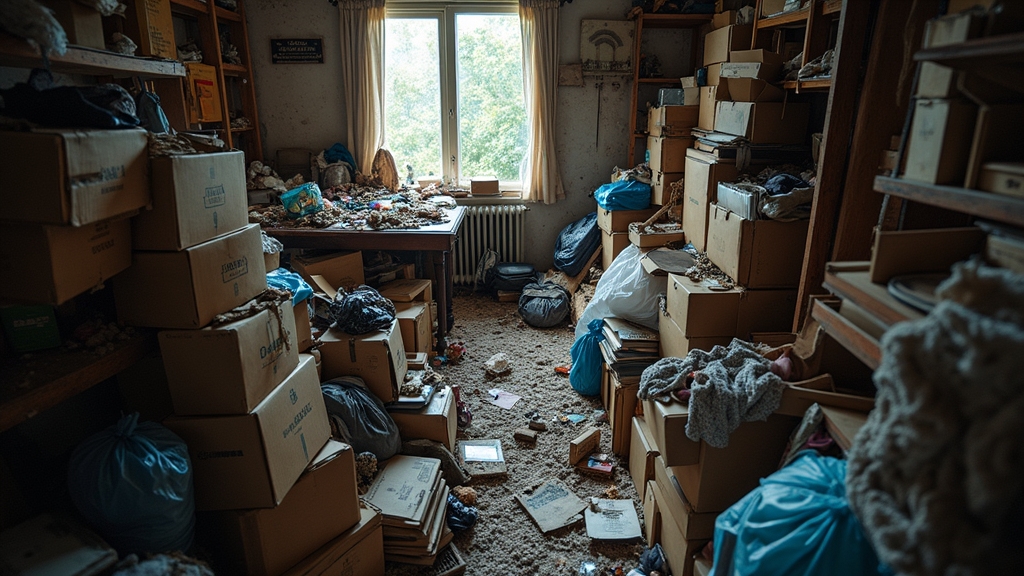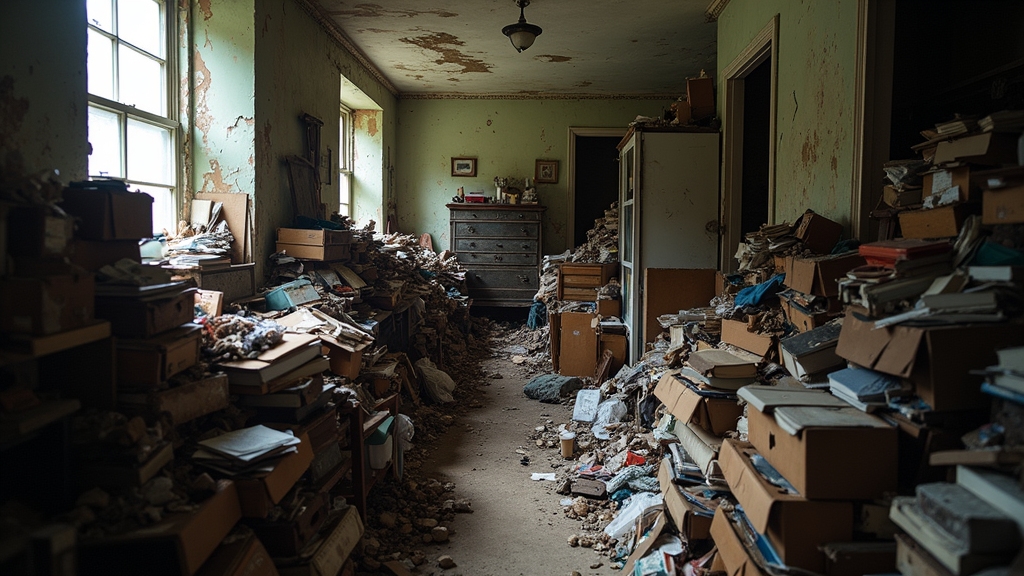Selling a hoarder house is a big challenge. Clutter, odors, and damage can scare off most buyers. Many sellers feel lost and unsure how to attract serious offers.
The mess can make the property look worse than it really is. Buyers might assume major problems and offer very low prices. This situation can cause long delays and frustration for everyone involved.
You can successfully market a hoarder house by targeting the right buyers, setting a fair price, and using smart marketing tactics. A focused plan helps change negative impressions.
The right steps can turn a difficult sale into a great opportunity. This blog will guide you through proven ways to sell a hoarder home for the best price.
Key Takeaways
- Prioritize deep cleaning and decluttering to maximize space, curb appeal, and overall presentation for potential buyers.
- Make all required legal disclosures about property condition, including hazards, repair needs, and any updates performed.
- Stage key rooms with neutral décor and good lighting to highlight the home’s potential and appeal to a broader audience.
- Use professional, well-framed photos that showcase the property’s best features while accurately representing its condition.
- Clearly advertise the property’s value, investment potential, and recent improvements to attract motivated buyers and investors.
Understanding the Challenges of Selling a Hoarder House

Selling a hoarder house can be difficult due to several clear challenges. Heavy clutter, messy furniture, and poor curb appeal can lower the home’s value. Buyers may feel overwhelmed and lose interest quickly. Unrealistic pricing can also discourage potential buyers if the house is not properly valued, making it crucial to set a competitive price based on accurate market data.
Homes with bad presentations get fewer inquiries from buyers. If rooms are crowded or messy, people cannot see the home’s potential. Neglected landscaping also makes the property less attractive from the street. Proper valuation and understanding of inheritance basis can help in establishing a realistic asking price.
Professional cleaning and simple staging can make a big difference. If you fix obvious problems and update the look, buyers may feel more confident. Listing repairs and updates gives you a plan to improve the property’s value.
Identifying Your Target Buyers
To identify your target buyers for a hoarder house, focus on those seeking investment opportunities. Most buyers are investors, flippers, or bargain hunters. These buyers look for homes with profit potential after repairs. If you market the home, highlight features like space for storage or flexible layouts. Investors often want properties where they can add value or make improvements. You should avoid targeting buyers who prefer move-in-ready or spotless homes. Consider advertising the property’s potential for creative renovations or rental income.
Emphasizing storage solutions can attract buyers who think about practical upgrades. Additionally, utilizing public records to find recent cash transactions can help identify active investors interested in such properties. Leveraging the benefits of cash buyers can significantly enhance your selling prospects, especially in competitive markets. Focus your efforts on people interested in sweat equity or redevelopment.
Assessing the Property’s Condition

You must check the property’s condition before listing a hoarder house. Look at its structure, major systems, and level of clutter. This helps set a fair price and plan your sale.
Professional inspections can show hidden problems and risks. If you find serious damage, repairs may be needed before selling. Fixing key issues can raise the home’s value.
Start by checking the HVAC, plumbing, and electrical systems. Examine the foundation, roof, and walls for any damage. If you see leaks, cracks, or mold, record them carefully.
Count how much clutter blocks doors or rooms. If clutter stops appraisers or buyers from seeing the space, note this. Good records help you decide on cleanup or repairs.
If you use a checklist, your evaluation will be faster and more accurate. A clear assessment gives you a better marketing plan. This approach makes the selling process smoother.
Cleaning and Decluttering Strategies
Cleaning and decluttering a hoarder house increases buyer interest and property value. Focus on high-impact areas like kitchens, bathrooms, and entryways. These spaces often give the best return according to real estate data.
Begin with a detailed list of all areas and items. If needed, hire professional junk removal services for faster results. Temporary storage solutions can help clear space quickly.
Sort everything into keep, donate, or discard groups. A team with experience in sensitive cleanups will make the process smoother. Emotional support can improve cooperation if residents feel overwhelmed.
Use strong cleaning products to remove odors and any biohazards. If you document the clean-up with before-and-after photos, you can use them for marketing. A clear, organized approach helps attract buyers seeking move-in-ready homes.
Deciding What Repairs and Updates to Make

Focus first on essential repairs that impact habitability, then target cost-effective updates that maximize ROI. You’ll want to address safety issues and ensure the property meets local code requirements to avoid inspection setbacks. Prioritizing these elements positions the house competitively in the market and reduces buyer objections.
Additionally, considering home size and usable space can attract more buyers and enhance the property’s appeal. Streamlining the process by selling to cash buyers can also help facilitate quick transactions, especially when urgent or complex situations arise.
Prioritizing Essential Repairs
A hoarder house needs essential repairs first to increase its value and attract buyers. Focus on fixes that improve safety, structure, and first impressions. If you prioritize these repairs, you use your budget more effectively.
Safety hazards like faulty wiring, leaks, or mold must be fixed right away. Structural problems with the roof, foundation, or walls should come next. If these issues remain, buyers may lose interest or face loan problems.
HVAC systems and utilities must work well before you list the home. Functional heating, cooling, and plumbing are basic buyer expectations. If any of these fail, offers may drop.
Consider using feng shui to arrange the entryway and main rooms. This can help create a welcoming feeling for buyers. If the house feels inviting, it may sell faster.
Cost-Effective Updates
Cost-effective updates help you get the most money when selling a hoarder house. Focus on changes that give the best return. Cosmetic updates like fresh paint, new lights, and modern hardware usually add the most value.
Staged homes often sell faster than unstaged ones. Basic staging helps buyers imagine how the space could look. If you remove old window coverings and deep-clean carpets, you can remove odors and make the home more inviting.
If you want the best results, choose updates that will appeal to many buyers. Avoid spending too much on major renovations. Small, strategic changes usually offer the best return in distressed homes.
Safety and Code Compliance
Safety and code compliance are essential before selling a hoarder house. Inspectors and buyers look for hazards and code violations. You must fix these issues to avoid problems during the sale.
Begin by correcting all code violations. Update old wiring, plumbing, and HVAC systems if they do not meet current standards. Fixing these can help your house sell faster.
Address any structural problems, such as foundation cracks or roof leaks. Repair damaged supports to prevent future issues. If you see mold or pests, remove them right away.
Always secure the required permits for repairs. Make sure all work follows local building codes. This approach reduces your risk and builds buyer confidence.
Once the house is safe and legal, consider home staging and virtual tours. These tools can help your property attract more buyers. A move-in ready home stands out in the market.
Working With Professional Cleaners or Junk Removal Services
You need to vet cleaning and junk removal companies based on reviews, insurance coverage, and turnaround times to ensure reliable results. Establishing a trustworthy service is essential to avoid potential issues during cleanup. Align your cleanup schedule with your listing timeline to minimize market delays and maximize buyer interest.
Leveraging reputable pros streamlines the process, reduces liability, and boosts your property’s market-readiness. Additionally, understanding the emotional aspects of homeownership can help you manage the sentimental challenges that may arise during the sale process.
Choosing Reputable Service Providers
Choosing reputable service providers is important when cleaning a hoarder house. Reliable cleaners or junk removal companies help you meet local rules and speed up the process. Good providers have insurance and understand waste disposal laws in your area.
If you want the best results, always check a company’s background. Ask for proof of certifications and see if they are trained in biohazard cleaning. You should ask for before-and-after photos and references from past clients.
Make sure the provider offers all the services you need. This could include deep cleaning, hazardous material removal, or itemized disposal. Request a clear, written estimate to compare with local prices.
If you follow these steps, you reduce risks and prepare the home for sale. Careful vetting helps you choose the right service for your needs. This approach also supports a faster and safer home transformation.
Coordinating Cleanup Timelines
Coordinating cleanup timelines means setting a clear schedule for the cleaning team. You should make a plan before the work begins. This will help everyone know what to do and when.
A detailed assessment can identify priority areas and items that may cause emotional stress. If you find hazardous materials, address those first for safety. Mark items that need special attention or extra care.
Phased cleanouts usually take three to seven days and are most effective. If you break work into steps, it prevents overwhelm and delays. Daily check-ins help track progress and catch problems early.
Early use of storage solutions makes the job smoother. You can rent storage pods or use offsite units for important items. This helps reduce stress and keeps things organized.
If you follow these steps, your property will be ready for sale faster. A clear plan increases your home’s appeal and value. Good organization makes the process easier for everyone involved.
Staging Tips for Hoarder Houses
Staging a hoarder house can help attract more buyers and increase its value. The goal is to make the home look organized and welcoming. If you use the right staging steps, buyers may see the property’s true potential.
Key spaces like the kitchen, living room, and main bedroom should be your main focus. Most buyers pay the most attention to these areas. If these rooms look good, buyers are more likely to be interested.
Neutral furniture gives the home a simple and modern look. Buyers find it easier to picture their own things in the space. If you keep the style basic, the rooms seem bigger.
Lighting can make a big difference in any home. Bright rooms look larger and more inviting. If you add lamps or open curtains, the house may feel more cheerful.
Clean and clear surfaces matter to buyers. Tables and counters without clutter show that the house is ready for a new start. If the home looks tidy, its value may go up.
Additionally, understanding how market demand influences buyer preferences can help you tailor your staging efforts to appeal to potential cash home buyers in Kansas City. Incorporating up-to-date market insights can further refine your approach and attract serious offers.
Taking Honest but Attractive Listing Photos
Focus your lens on core property features, using tight shots to minimize visual clutter and direct buyer attention. Statistically, listings that highlight cleaned, organized spaces boost engagement rates by up to 60%. Capture rooms from angles that showcase upgrades or spaciousness, ensuring photos remain transparent yet appealing. Additionally, emphasizing the property’s structural integrity can reassure buyers concerned about termite damage and other issues.
Show Key Property Features
A good photo set helps buyers see the key features of a hoarder house. Pictures should clearly show the home’s size, structure, and any upgrades. Photos must be honest about the home’s true condition.
Upgraded systems or appliances should be photographed clearly if present. Exterior photos need to highlight landscaping or decorative changes. Wide shots can help buyers understand the space and layout.
Architectural details and storage areas should be included if they add value. Unique features can set the property apart in a positive way. If buyers see clear potential, they are more likely to be interested.
Minimize Visual Clutter
To minimize visual clutter, use simple photo techniques that show the real state of the home. Wide-angle lenses help display room size, but avoid angles that distort the space. Remove small, non-essential items to create a cleaner look.
Focus each photo on the room’s layout and potential uses. If possible, highlight storage solutions to show ways to organize the space. If the seller is attached to their belongings, handle items carefully.
NAR data shows that clean, organized photos attract 83% of buyers and boost interest by up to 32%. Honest photos help buyers understand the home’s true condition. Always use framing to clarify the layout, not to hide problems.
Highlight Cleaned Spaces
Clean and organized spaces make a strong first impression in photos. These areas help buyers picture themselves living in the home. If rooms look tidy, buyers may feel more confident about the property’s condition.
Photos should show areas with smart storage, such as built-in shelves or organized closets. Surfaces that shine, like polished floors or clean appliances, also attract attention. Natural light can make rooms appear bigger and cleaner.
You can include before-and-after photos to highlight improvements. If you show these changes, buyers may trust the listing more. Honest, clear images help set realistic expectations.
Writing a Compelling Property Description
A clear property description can help sell a hoarder house. Buyers want to know the value, not just the condition. If you mention the square footage, lot size, and neighborhood, buyers may see the potential. Highlight any recent improvements or staging work. Virtual tours let buyers view the space from home, which increases interest. If buyers can see the layout, they may be more willing to make an offer.
Call the property a “blank canvas” or “ready for renovation” if it needs work. Mention any strong features, like solid structure or unique design. If you show the investment potential, you could attract buyers who want high returns. Additionally, emphasizing the property’s swift sale benefits can appeal to buyers looking for quick transactions during relocations.
Disclosing Property Issues Transparently
You need to meet all legal disclosure requirements by clearly reporting known defects and material facts about the property. Spell out necessary repairs and remediation to set accurate buyer expectations and reduce post-inspection renegotiations. Transparent communication boosts buyer trust, increasing the odds of a smoother transaction and fewer liabilities.
Legal Disclosure Requirements
Sellers can protect themselves by making full legal disclosure about the property. Most places require this by law. Honest disclosure also helps build trust with buyers.
State disclosure forms must list all known problems with the house. Sellers should keep records of all repairs and cleaning done. These documents show what issues were fixed.
You must tell buyers about hazards like mold, pests, or structural damage. If you hide problems, you may face lawsuits later. Consulting a real estate attorney ensures you follow all rules.
Proper disclosure protects your reputation and avoids legal trouble. Accurate information keeps the sales process fair for everyone. If you disclose everything, buyers are more likely to trust you.
Highlighting Repair Needs
Buyers want to know the real condition of your property. Hoarder houses often hide problems that need repair. It is important to list all needed repairs clearly.
You should point out issues like bad wiring, water leaks, or mold. Always back up repair needs with contractor estimates. Clear condition reports help set correct prices and avoid long negotiations.
If you document repairs, buyers know what to expect. You can use a table to show each problem and possible solution:
| Repair Issue | Solution / Estimate |
|---|---|
| Damaged flooring | $4,000 replacement; disclose now |
| Mold remediation | $2,500 professional treatment |
| Outdated wiring | $3,000 electrical upgrade |
| Plumbing leaks | $1,200 repairs |
A transparent approach builds trust and justifies your asking price. This also helps you plan staging and repairs more easily.
Building Buyer Trust
Building buyer trust starts with clear and honest information. Buyers need to know about the condition of a hoarder house. If you share important details, buyers feel more confident and are less likely to back out.
Sellers should give inspection reports about the structure, wiring, and plumbing. A record of the neighborhood’s history, like crime rates, is also helpful. If you know about mold or pests, you should mention them and give repair estimates.
Providing a list of repair costs helps buyers plan their budgets. These actions show you are honest and reliable. If you do this, you will attract buyers who are ready to purchase.
Pricing the Home Competitively
Pricing is very important when selling a hoarder house. A fair price attracts buyers who understand the work involved. If you price too high, fewer people will show interest.
You should look at recent sales of similar homes in poor condition. Adjust your price for things like location and how much work the house needs. Home staging experts can help estimate how much value repairs might add. Neighborhood comps can provide insight into appropriate pricing based on recent sales of comparable homes in the area.
Additionally, understanding the visual appeal of your property can help you set a price that highlights its greatest aspects and attracts serious buyers.
Competitive pricing encourages more offers and speeds up the sale. If you set the right price, you can create urgency among buyers. This helps you sell faster and get the best return possible.
Marketing to Investors and Flippers
To reach investors and flippers, focus on the future value of the property rather than its current state. These buyers look for homes with potential, not perfection. Show them how the property can become profitable.
If you highlight the possible return on investment, investors will pay attention. Share after-repair value estimates and compare them to similar homes nearby. Use real numbers to show the profit they could make.
Virtual or partial home staging can help buyers imagine the finished product. Even online staging helps investors picture the space’s possibilities. If buyers see the end result, they may act faster.
Offer 3D virtual tours for remote viewing, which saves time for busy investors. Transparent tours set clear expectations about the home’s condition. This approach can build trust with buyers.
If the property is in an opportunity zone, mention tax breaks or special programs. Investors often look for these extra benefits. Relevant incentives can make your property more appealing.
Investors and flippers care most about potential, numbers, and efficiency. Speak directly to these priorities in your marketing. Simple, clear information builds buyer confidence.
Leveraging Online and Offline Advertising Channels
Reaching the right buyers for a hoarder house means using both online and offline advertising channels. A multi-channel strategy increases your chances of finding interested buyers quickly. Online and offline methods together can lead to better results. Utilizing market research to identify buyer preferences and trends can further optimize your marketing efforts.
Online options include listing on popular real estate websites and using targeted social media ads. Niche platforms for investors can also help reach buyers who look for fixer-uppers. Virtual tours can show the property’s potential and attract remote buyers. If you use professional staging in clean areas, buyers can better imagine the home’s value.
Listings with virtual tours often get more attention and sell faster. If you want to boost interest, invest in clear photos and honest descriptions. Offline strategies like yard signs and direct mail can still bring in local buyers. Investor meetups are useful if you want to target people who buy homes as-is. Combining these methods will help you reach more buyers and sell faster.
Partnering With Real Estate Agents Experienced in Distressed Properties
Partnering with real estate agents who know how to sell distressed properties makes selling a hoarder house easier. These agents have experience with homes that need special attention. They know how to find the right buyers and get the best price.
Experienced agents use smart marketing to reach more buyers. They can suggest home staging ideas that help buyers see the home’s potential. If you allow it, they may also use virtual tours to attract people from other places.
Some agents have contacts with investors and cash buyers interested in as-is homes. They are skilled in negotiating quick deals. If you want to avoid repairs or long waits, these agents can help speed up the sale.
Conclusion
If you use the right marketing approach, selling a hoarder house becomes much easier. Targeted advertising and honest disclosures can attract serious buyers. Professional guidance helps you show the property’s true potential.
If you want to avoid the hassle, you can sell your house for cash. We buy houses for cash and handle the process quickly. This option is ideal if you want a simple, stress-free sale.
If you are ready to sell, contact Limitless Homes of KC today. We can help you get a fair cash offer. Let us turn your property into an opportunity for you.

